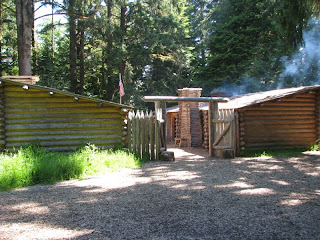May 26, 2024 – Natchez Trace Parkway, TN
Sunday, we started back on the Parkway to complete our 444-mile journey. We stopped at Phosphate Mine where the Parkway passes through or near a geologic region of limestone rich in phosphate deposits. Phosphate was mined here for fertilizer starting about 1880. We took a short hike along an abandoned railroad bed that passed a couple of collapsed mineshafts.
The abandoned railroad bed we hiked on was where
“Dinkey” engines on miniature tracks hauled small pushcarts of blue phosphate
ore to a washer. We hiked past another
collapsed mineshaft.
Our next stop was at Fall Hollow where we hiked another short trail to some waterfalls.
The first waterfall was easy to hike to and was
beautiful.
As we continued the trail got steeper and we found another great waterfall.
Nancy and Tacky at the bottom of the waterfall and the
end of the trail. Now we have to hike
back up this steep and slippery trail.
There were not many flowers along the trail, but we did
see these. We don’t know what they are,
but they are beautiful.
After our hike we moved on to an old tobacco barn from the early 1900s.
If you look closely, you can see tobacco hanging to
dry in the barn.
We then drove a 2-mile section of the original Old
Trace. Another beautiful drive.
At our next stop we were able to hike on the original
Old Natchez Trace. It was beautiful but
we can imagine how difficult it was in the early 1800s to travel 20 to 30 miles
a day on foot or horseback along the Trace.
After our hike we stopped at Jackson Falls where we
took a short but steep path to the falls.
This is the top part of the falls.
We were rewarded at the bottom of the path with this
beautiful view of the falls.
After climbing back up from the falls we hiked to
Baker Bluff Overlook. We hiked back to
the picnic area and ate lunch.
After lunch we stopped at The Gordon House. One of the few remaining buildings associated with the Old Natchez Trace is the house of ferry operator John Gordon. In the early 1800s Gordon made an agreement with the Chickasaw Chief George Colbert to operate a trading post and ferry on the Duck River. Military expeditions with General Andrew Jackson kept him away from home much of the time. His wife Dorathea supervised the construction of the present house in 1817-18. John Gordon died shortly after it was completed, but Mrs. Gordon lived here until her death in 1859.
We next stopped at the War of 1812 Memorial. The monument memorializes War of 1812 soldiers buried along the Old Natchez Trace, and it honors the service of all brave volunteers who marched on the Natchez Trace during the War of 1812 to help establish American independence. The Natchez Trace served as an important route to move troops for the defense of the gulf coast region.
It started raining as we stopped to get a picture of this double arch bridge where the Parkway crosses TN Hwy 96 near the end of the Parkway. We can see why this bridge won the 1995 Presidential Award for Design Excellence.
As we got back to the Jeep from viewing the bridge the storm worsened and it was pouring rain. We drove to the end of the Parkway and looked for mile marker 444 but couldn’t find it. On the way back down the Parkway the storm intensified, and it started hailing.
The hail got larger, and we were forced to pull over and tried to get under some trees for a little protection. The Jeep now has some dents in the hood but fortunately, the hail did not break our windshield.
We had a great time driving the Natchez Trace Parkway
and can now cross it off our Bucket List.
.JPG)
.JPG)
.JPG)
.JPG)
.JPG)
.JPG)
.JPG)
.JPG)
.JPG)
.JPG)
.JPG)
.JPG)
.JPG)
.JPG)
.JPG)
.JPG)
.JPG)
.JPG)
.jpg)
.jpg)


.JPG)
Comments
Post a Comment